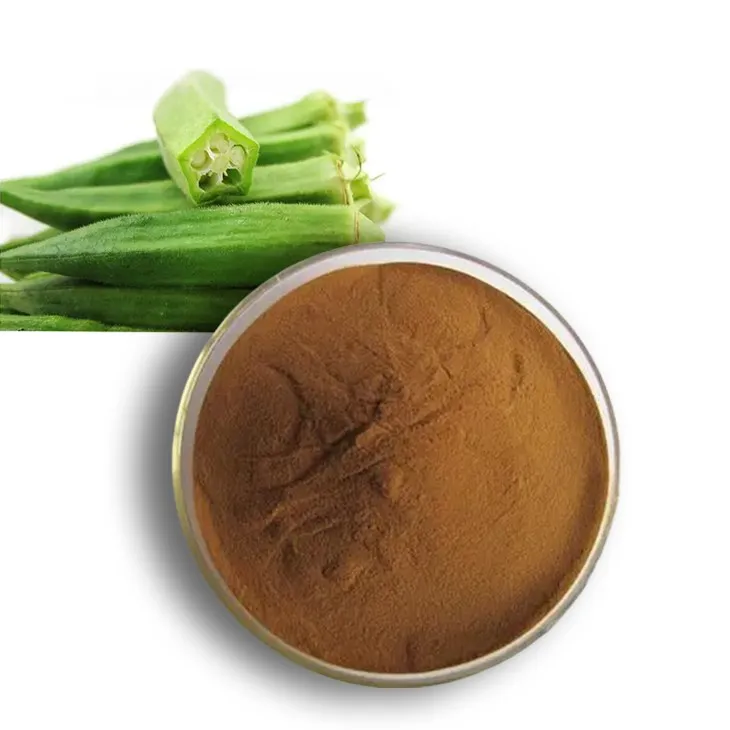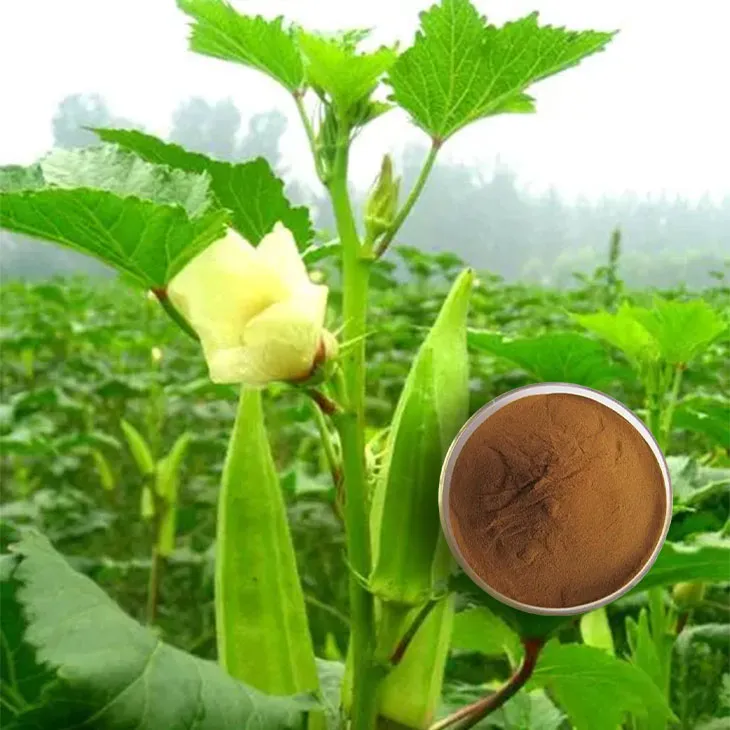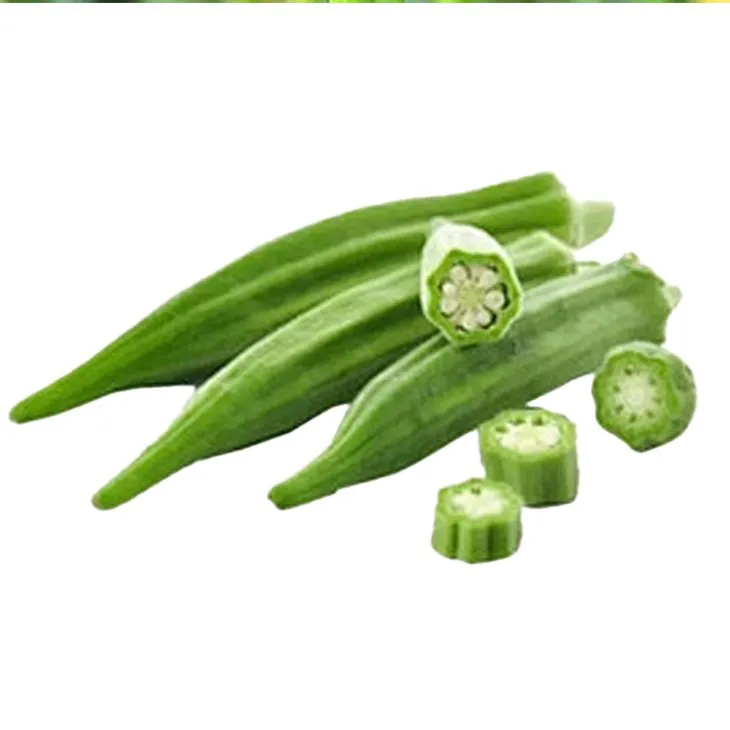- 0086-571-85302990
- sales@greenskybio.com
Supercritical Carbon Dioxide Extraction of Okra Extract.
2024-11-28

1. Introduction
Okra, a widely cultivated plant, has drawn increasing attention due to its potential health benefits. The extraction of Okra Extracts using supercritical carbon dioxide (scCO₂) has emerged as an innovative and efficient method. Supercritical CO₂ offers several advantages over traditional extraction methods, such as reduced solvent residue, mild operating conditions, and high selectivity.

2. Basic Principles of Supercritical Fluid Extraction
2.1. Supercritical State
A supercritical fluid is a substance that is maintained above its critical temperature and critical pressure. For carbon dioxide, the critical temperature is around 31.1 °C, and the critical pressure is approximately 7.38 MPa. In this supercritical state, CO₂ exhibits properties intermediate between those of a gas and a liquid. It has a low viscosity like a gas, allowing for good mass transfer, and a high density like a liquid, enabling it to dissolve a wide range of substances.2.2. Extraction Process
In the supercritical fluid extraction process, supercritical CO₂ is used as a solvent. The okra sample is placed in an extraction vessel. The supercritical CO₂ is pumped into the vessel at a certain pressure and temperature. The CO₂ penetrates the okra matrix and selectively dissolves the target compounds. Then, the CO₂ - compound mixture is transferred to a separation vessel where, by changing the pressure or temperature, the CO₂ reverts to a gas state, leaving the extracted compounds behind.
3. Chemical Composition of Okra
Okra contains a variety of compounds. It is rich in polysaccharides, such as mucilage, which has potential health - promoting properties. It also contains phenolic compounds, flavonoids, vitamins (e.g., vitamin C, vitamin K), and minerals (e.g., potassium, magnesium). These components contribute to okra's antioxidant, anti - inflammatory, and other bioactive functions.

4. Targeting Specific Compounds in Okra with scCO₂
4.1. Selectivity of scCO₂
Supercritical carbon dioxide can be adjusted in terms of its pressure and temperature to target specific compounds in okra. For example, at certain pressure - temperature conditions, it can preferentially dissolve phenolic compounds. The polarity of scCO₂ can be modified by adding small amounts of co - solvents, such as ethanol, to enhance the extraction of more polar compounds.4.2. Influence of Process Parameters
Parameters like pressure, temperature, extraction time, and flow rate of CO₂ significantly affect the extraction efficiency and selectivity. Higher pressures generally increase the solubility of compounds in scCO₂, but too high a pressure may also lead to the extraction of unwanted components. Temperature affects both the density of scCO₂ and the stability of the target compounds. Optimal extraction time and flow rate need to be determined to ensure maximum extraction yield while maintaining the quality of the extract.5. Bioactive Properties of Okra Extracts Obtained by scCO₂ Extraction
5.1. Antioxidant Properties
The phenolic compounds and flavonoids extracted from okra using scCO₂ have strong antioxidant activity. Antioxidants are important in neutralizing free radicals in the body, which are associated with various diseases such as cancer, cardiovascular diseases, and neurodegenerative disorders. The antioxidant capacity of Okra Extracts can be measured by methods such as the DPPH (2,2 - diphenyl - 1 - picrylhydrazyl) radical scavenging assay and the ABTS (2,2' - azinobis - (3 - ethylbenzothiazoline - 6 - sulfonic acid)) assay.5.2. Anti - inflammatory Properties
Okra extracts obtained through scCO₂ extraction may also possess anti - inflammatory properties. Inflammation is a complex biological response that can lead to chronic diseases if not properly regulated. The bioactive compounds in okra extracts can interfere with the inflammatory pathways, reducing the production of pro - inflammatory cytokines. This anti - inflammatory effect can be studied in vitro using cell - based assays and in vivo using animal models.5.3. Other Potential Bioactive Properties
There are other potential bioactive properties of okra extracts. For example, the polysaccharides in okra may have prebiotic effects, promoting the growth of beneficial gut bacteria. Additionally, some compounds in okra may have anti - diabetic properties, although more research is needed to fully understand these mechanisms.6. Future Prospects in Different Sectors
6.1. Food and Beverage Industry
- In the food and beverage industry, okra extracts obtained by scCO₂ extraction can be used as natural additives. They can be added to functional foods and beverages to enhance their nutritional value and health - promoting properties. For example, they can be used in juices, smoothies, or dietary supplements. - Okra extracts can also be used for flavor enhancement. The unique flavor profile of okra can add a new dimension to food products.6.2. Pharmaceutical Industry
- The bioactive properties of okra extracts make them potential candidates for drug development. They can be further studied and developed into new drugs for the treatment of various diseases, especially those related to oxidative stress and inflammation. - Pharmaceutical companies can also use okra extracts in the development of nutraceuticals, which are products that bridge the gap between food and medicine.6.3. Cosmetic Industry
- In the cosmetic industry, the antioxidant and anti - inflammatory properties of okra extracts can be utilized. They can be added to skin care products such as creams, lotions, and serums to protect the skin from oxidative damage and reduce inflammation, resulting in healthier - looking skin. - Okra extracts may also have moisturizing properties due to the presence of polysaccharides, which can improve the skin's hydration level.7. Conclusion
The supercritical carbon dioxide extraction of okra extracts is a promising area of research. It allows for the efficient extraction of valuable compounds from okra with high selectivity. The okra extracts obtained through this method possess various bioactive properties, which have potential applications in different sectors. However, further research is still needed to optimize the extraction process, fully understand the bioactive mechanisms, and explore more potential applications. With continuous development, it is expected that okra extracts obtained by scCO₂ extraction will play an increasingly important role in promoting human health and the development of related industries.
FAQ:
What is the basic principle of supercritical fluid extraction in the context of okra extraction?
Supercritical fluid extraction is based on the unique properties of a supercritical fluid, such as supercritical carbon dioxide. In this state, the fluid has properties between those of a liquid and a gas. For okra extraction, supercritical CO₂ can penetrate the plant material easily like a gas and dissolve the target compounds like a liquid. It can then be separated from the extract by changing the pressure and temperature conditions, allowing for the selective extraction of specific components from okra.
What are the main chemical components in okra that can be targeted by supercritical carbon dioxide extraction?
Okra contains various components such as polysaccharides, flavonoids, phenolic compounds, and vitamins. Supercritical carbon dioxide can target lipophilic (fat - loving) compounds in particular. For example, some of the volatile oils and lipid - soluble antioxidants in okra can be effectively extracted. However, depending on the extraction parameters (pressure, temperature, etc.), it can also influence the extraction of other compounds to some extent.
How do okra extracts obtained through supercritical carbon dioxide extraction show antioxidant properties?
The antioxidant properties of okra extracts obtained by this method are related to the presence of certain compounds. For instance, phenolic compounds and flavonoids extracted are known to have antioxidant activity. These compounds can scavenge free radicals in the body, which are associated with oxidative stress. The supercritical extraction process can effectively isolate these antioxidant - rich components from okra, thus enhancing the overall antioxidant potential of the extract.
What are the anti - inflammatory mechanisms of okra extracts obtained via supercritical carbon dioxide extraction?
Some of the compounds in okra extracts, such as flavonoids, may play a role in anti - inflammation. They can interact with the body's inflammatory pathways, for example, by inhibiting the production of pro - inflammatory cytokines. When extracted using supercritical carbon dioxide, these bioactive compounds are isolated in a more targeted manner, potentially enhancing their anti - inflammatory effects. However, further research is needed to fully understand the detailed mechanisms at play.
What are the future prospects of okra extracts obtained through supercritical carbon dioxide extraction in the food industry?
In the food industry, okra extracts obtained by this method could be used as natural additives. For example, they could be added to food products as antioxidants to extend shelf - life. They might also be used to enhance the nutritional value of foods due to the presence of various bioactive compounds. Additionally, the extracts could potentially be used in the development of functional foods, targeting consumers interested in health - promoting products.
Related literature
- Supercritical Fluid Extraction of Bioactive Compounds from Okra: Optimization and Characterization"
- "Okra Extracts: Properties and Potential Applications in Health and Food"
- "Supercritical Carbon Dioxide Extraction: A Promising Technique for Okra - Based Bioactive Product Development"
- ▶ Hesperidin
- ▶ Citrus Bioflavonoids
- ▶ Plant Extract
- ▶ lycopene
- ▶ Diosmin
- ▶ Grape seed extract
- ▶ Sea buckthorn Juice Powder
- ▶ Fruit Juice Powder
- ▶ Hops Extract
- ▶ Artichoke Extract
- ▶ Mushroom extract
- ▶ Astaxanthin
- ▶ Green Tea Extract
- ▶ Curcumin
- ▶ Horse Chestnut Extract
- ▶ Other Product
- ▶ Boswellia Serrata Extract
- ▶ Resveratrol
- ▶ Marigold Extract
- ▶ Grape Leaf Extract
- ▶ New Product
- ▶ Aminolevulinic acid
- ▶ Cranberry Extract
- ▶ Red Yeast Rice
- ▶ Red Wine Extract
-
Medicinal Marshmallow Extract
2024-11-28
-
Hericium erinaceus extract powder
2024-11-28
-
Kelp Extract Powder
2024-11-28
-
Senna Leaf Extract
2024-11-28
-
Lily extract
2024-11-28
-
White mustard seed extract
2024-11-28
-
Almond Extract Powder
2024-11-28
-
Oyster Mushroom Extract Powder
2024-11-28
-
Citrus Aurantii Extract
2024-11-28
-
Curcumin
2024-11-28





















